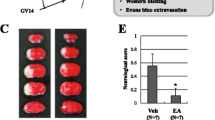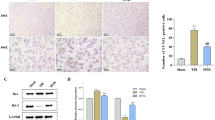Abstract
Objective
To explore the protective effect of bloodletting acupuncture at twelve Jing-well points on hand (BAJP) on acute hypobaric hypoxia (AHH)-induced brain injury in rats and its possible mechanisms.
Methods
Seventy-five Sprague Dawley rats were divided into 5 groups by a random number table (n=15), including control, model, BAJP, BAJP+3-methyladenine (3-MA), and bloodletting acupuncture at non-acupoint (BANA, tail tip blooding) groups. After 7-day pre-treatment, AHH models were established using hypobaric oxygen chambers. The levels of S100B, glial fibrillary acidic protein (GFAP), superoxide dismutase (SOD), and malondialdehyde (MDA) in serum were measured by enzyme-linked immunosorbent assay. Hematoxylin-eosin staining and the terminal deoxynucleotidyl transferase-mediated dUTP-biotin nick end labeling method were used to assess hippocampal histopathology and apoptosis. Transmission electron microscopy assay was used to observe mitochondrial damage and autophagosomes in hippocampal tissues. Flow cytometry was used to detect mitochondrial membrane potential (MMP). The mitochondrial respiratory chain complexes I, III and IV activities and ATPase in hippocampal tissue were evaluated, respectively. Western blot analysis was used to detect the protein expressions of Beclin1, autophagy protein 5 (ATG5), microtubule-associated protein 1 light chain 3 beta (LC3B), phosphatase and tensin homolog induced kinase 1 (PINK1), and Parkin in hippocampal tissues. The mRNA expressions of Beclin1, ATG5 and LC3-II were analyzed by quantitative real-time polymerase chain reaction.
Results
BAJP treatment reduced hippocampal tissue injury and inhibited hippocampal cell apoptosis in AHH rats. BAJP reduced oxidative stress by decreasing S100B, GFAP and MDA levels and increasing SOD level in the serum of AHH rats (P<0.05 or P<0.01). Then, BAJP increased MMP, the mitochondrial respiratory chain complexes I, III and IV activities, and the mitochondrial ATPase activity in AHH rats (all P<0.01). BAJP improved mitochondrial swelling and increased the autophagosome number in hippocampal tissue of AHH rats. Moreover, BAJP treatment increased the protein and mRNA expressions of Beclin1 and ATG5 and LC3-II/LC3-I ratio in AHH rats (all P<0.01) and activated the PINK1/Parkin pathway (P<0.01). Finally, 3-MA attenuated the therapeutic effect of BAJP on AHH rats (P<0.05 or P<0.01).
Conclusion
BAJP was an effective treatment for AHH-induced brain injury, and the mechanism might be through reducing hippocampal tissue injury via increasing the PINK1/Parkin pathway and enhancement of mitochondrial autophagy.
Similar content being viewed by others
References
Liu X, Zhang Y, Li Y, Pan J, Wang D, Chen W, et al. EPAS1 gain-of-function mutation contributes to high-altitude adaptation in Tibetan horses. Mol Biol Evol 2019;36:2591–2603.
Li K, He C. Gastric mucosal lesions in Tibetans with high-altitude polycythemia show increased HIF-1A expression and ROS production. Bio Med Res Int 2019;2019:6317015.
Zhang P, Chen JS, Li QY, Sheng LX, Gao YX, Lu BZ, et al. Neuroprotectants attenuate hypobaric hypoxia-induced brain injuries in cynomolgus monkeys. Zool Res 2020;41:3–19.
Luks AM, Swenson ER, Bartsch P. Acute high-altitude sickness. Eur Respir Rev 2017;26:160096.
Li N, Li Q, Bai J, Chen K, Yang H, Wang W, et al. The multiple organs insult and compensation mechanism in mice exposed to hypobaric hypoxia. Cell Stress Chaperon 2020;25:779–791.
Tang H, Qin S, Li W, Chen X, Ulloa L, Zhu Q, et al. P2RX7 in dopaminergic neurons of ventral periaqueductal gray mediates HTWP acupuncture-induced consciousness in traumatic brain injury. Front Cell Neurosci 2021;14:598198.
Yu NN, Xu ZF, Gao Y, Zhou ZL, Zhao X, Zhou D, et al. Wake-promoting effect of bloodletting puncture at hand twelve Jing-well points in acute stroke patients: a multi-center randomized controlled trial. Chin J Integr Med 2021;27:570–577.
Yu N, Wang Z, Chen Y, Yang J, Lu X, Guo Y, et al. The ameliorative effect of bloodletting puncture at hand twelve Jing-well points on cerebral edema induced by permanent middle cerebral ischemia via protecting the tight junctions of the blood-brain barrier. BMC Complement Altern Med 2017;17:470.
Li B, Zhou X, Yi TL, Xu ZW, Peng DW, Guo Y, et al. Bloodletting puncture at hand twelve Jing-well points improves neurological recovery by ameliorating acute traumatic brain injury-induced coagulopathy in mice. Front Neurosci 2020;14:403.
Wang C, Li MX, Li YD, Li YP. Bloodletting acupuncture at Jing-well points alleviates myocardial injury in acute altitude hypoxic rats by activating HIF-1alpha/BNIP3 signaling-mediated mitochondrial autophagy and decreasing oxidative stress. Chin J Integr Med 2023;29:170–178.
Towner RA, Saunders D, Smith N, Towler W, Cruz M, Do S, et al. Assessing long-term neuroinflammatory responses to encephalopathy using MRI approaches in a rat endotoxemia model. Geroscience 2018;40:49–60.
Yu A, Mao L, Zhao F, Sun B. Olfactory ensheathing cells transplantation attenuates chronic cerebral hypoperfusion induced cognitive dysfunction and brain damages by activating Nrf2/HO-1 signaling pathway. Am J Transl Res 2018;10:3111–3121.
Hao G, Eser P, Mo J. Oxidative stress and intracranial hypertension after aneurysmal subarachnoid hemorrhage. Antioxidants (Basel) 2022;11:2423.
Badawi S, Paccalet A, Harhous Z, Pillot B, Augeul L, Van Coppenolle F, et al. A dynamic transcriptional analysis reveals IL-6 axis as a prominent mediator of surgical acute response in non-ischemic mouse heart. Front Physiol 2019;10:1370–1370.
Yang Z, Lin P, Chen B, Zhang X, Xiao W, Wu S, et al. Autophagy alleviates hypoxia-induced blood-brain barrier injury via regulation of CLDN5 (claudin 5). Autophagy 2021;17:3048–3067.
Wang L, Lu Z, Zhao J, Schank M, Cao D, Dang X, et al. Selective oxidative stress induces dual damage to telomeres and mitochondria in human T cells. Aging Cell 2021;20:e13513.
Uchida D, Takaki A, Adachi T, Okada H. Beneficial and paradoxical roles of anti-oxidative nutritional support for nonalcoholic fatty liver disease. Nutrients 2018;10:977.
Popkov VA, Silachev DN, Zalevsky AO, Zorov DB, Plotnikov EY. Mitochondria as a source and a target for uremic toxins. Int J Mol Sci 2019;20:3094.
Jia CM, Zhang FW, Wang SJ, Wang W, Li Y. Tea polyphenols prevent sepsis-induced lung injury via promoting translocation of DJ-1 to mitochondria. Front Cell Dev Biol 2021;9:622507.
Deng X, Wang Q, Cheng M, Chen Y, Yan X, Guo R, et al. Pyruvate dehydrogenase kinase 1 interferes with glucose metabolism reprogramming and mitochondrial quality control to aggravate stress damage in cancer. J Cancer 2020;11:962–973.
Deitersen J, Berning L, Stuhldreier F, Ceccacci S, Schlütermann D, Friedrich A, et al. High-throughput screening for natural compound-based autophagy modulators reveals novel chemotherapeutic mode of action for arzanol. Cell Death Dis 2021;12:560–560.
Padman BS, Nguyen TN, Uoselis L, Skulsuppaisarn M, Nguyen LK, Lazarou M. LC3/GABARAPs drive ubiquitin-independent recruitment of Optineurin and NDP52 to amplify mitophagy. Nat Commun 2019;10:408–408.
Lee KH, Cha M, Lee BH. Neuroprotective effect of antioxidants in the brain. Int J Mol Sci 2020;21:7152.
Zhao SY, Liao LX, Tu PF, Li WW, Zeng KW. Icariin inhibits AGE-induced injury in PC12 cells by directly targeting apoptosis regulator bax. Oxid Med Cell Longev 2019;2019:7940808.
Mohammadi H, Shamshirian A, Eslami S, Shamshirian D, Ebrahimzadeh MA. Magnesium sulfate attenuates lethality and oxidative damage induced by different models of hypoxia in mice. BioMed Res Int 2020;2020:2624734.
Liu X, Xie JN, Yang L, Li Y, He Y, Liu Z, et al. Bone marrow mesenchymal stem cells enhance autophagy and help protect cells under hypoxic and retinal detachment conditions. J Cell Mol Med 2020;24:3346–3358.
Zhao M, Wang S, Zuo A, Zhang J, Wen W, Jiang W, et al. HIF-1α/JMJD1A signaling regulates inflammation and oxidative stress following hyperglycemia and hypoxia-induced vascular cell injury. Cell Mol Biol Lett 2021;26:40.
Yeh PS, Chen JT, Cherng YG, Yang ST, Tai YT, Chen RM. Methylpiperidinopyrazole attenuates estrogen-induced mitochondrial energy production and subsequent osteoblast maturation via an estrogen receptor alpha-dependent mechanism. Molecules 2020;25:2876.
Wei L, Zuo Z, Yang Z, Yin H, Yang Y, Fang J, et al. Mitochondria damage and ferroptosis involved in Ni-induced hepatotoxicity in mice. Toxicology 2022;466:153068.
Xue Y, Chen Q, Sun J. Hydroxyapatite nanoparticle-induced mitochondrial energy metabolism impairment in liver cells: in vitro and in vivo studies. J Appl Toxicol 2017;37:1004–1016.
Bo-Htay C, Shwe T, Higgins L, Palee S, Shinlapawittayatorn K, Chattipakorn SC, et al. Aging induced by D-galactose aggravates cardiac dysfunction via exacerbating mitochondrial dysfunction in obese insulin-resistant rats. Geroscience 2020;42:233–249.
Zhou Y, Long Q, Wu H, Li W, Qi J, Wu Y, et al. Topology-dependent, bifurcated mitochondrial quality control under starvation. Autophagy 2020;16:562–574.
Benjanuwattra J, Apaijai N, Chunchai T, Singhanat K, Arunsak B, Intachai K, et al. The temporal impact of erythropoietin administration on mitochondrial function and dynamics in cardiac ischemia/reperfusion injury. Exp Mol Pathol 2022;127:104802.
Shao ZQ, Dou SS, Zhu JG, Wang HQ, Wang CM, Cheng BH, et al. Apelin-13 inhibits apoptosis and excessive autophagy in cerebral ischemia/reperfusion injury. Neural Regen Res 2021;16:1044–1051.
Wang P, Shao BZ, Deng Z, Chen S, Yue Z, Miao CY. Autophagy in ischemic stroke. Prog Neurobiol 2018;163–164:98–117.
Wang Q, Zhang Q, Luan S, Yang K, Zheng M, Li K, et al. Adapalene inhibits ovarian cancer ES-2 cells growth by targeting glutamic-oxaloacetic transaminase 1. Bioorg Chem 2019;93:103315.
Cao Y, Li Q, Liu L, Wu H, Huang F, Wang C, et al. Modafinil protects hippocampal neurons by suppressing excessive autophagy and apoptosis in mice with sleep deprivation. Br J Pharmacol 2019;176:1282–1297.
Tian A, Ma X, Li H, Zhang R. Dl-3n-butylphthalide improves spatial learning and memory in rats with vascular dementia by reducing autophagy via regulation of the mTOR signaling pathway. Exp Ther Med 2020;19:1940–1946.
Author information
Authors and Affiliations
Contributions
Li YP, Li MX and Guo Y designed the experiments. Li YP, Li MX, Wang C, Li YD and Sa YP performed the experiments. Li YP and Li MX analyzed data, wrote this article, and contributed equally to the work.
Corresponding author
Ethics declarations
The authors report there are no competing interests to declare.
Additional information
Supported by the Applied Basic Research Project of Science and Technology Department of Qinghai Province (No. 2020-ZJ-760)
Rights and permissions
About this article
Cite this article
Li, Yp., Li, Mx., Wang, C. et al. Bloodletting Acupuncture at Jing-Well Points on Hand Induced Autophagy to Alleviate Brain Injury in Acute Altitude Hypoxic Rats by Activating PINK1/Parkin Pathway. Chin. J. Integr. Med. 29, 932–940 (2023). https://doi.org/10.1007/s11655-023-3597-0
Accepted:
Published:
Issue Date:
DOI: https://doi.org/10.1007/s11655-023-3597-0




